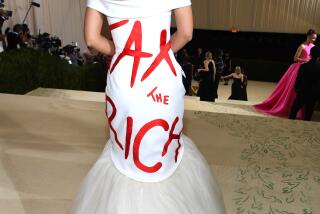The Bieber effect
Americans don’t seem bothered enough by the country’s growing wealth divide to do much about it, according to a recent Harvard Business School survey. In part, that’s probably because they vastly underestimate the gap, believing the top 20% own 59% of the nation’s wealth when they actually own 84%.
But there’s another, less obvious reason for our passivity — the hope and glory pushed by an all-pervasive news, gossip and star-driven celebrity culture.
The core of the American dream teaches us that the formula for achieving wealth involves hard work, determination and luck. Celebrities, and the coverage of them, seem to provide visible proof of this message every day: If it can happen to Justin Bieber, it can happen to me. So why change the system?
The connection between stardom and social mobility is as old as the first fan magazines of a century ago. Silent-film star Ruth Clifford was an orphan who peered through a knothole at the Edison Studios lot in New Jersey before getting her big break, according to a 1919 issue of Photoplay. Virginia Valli was a stenographer traveling through a dangerous part of Chicago while struggling to support her mother and sister before leading the “limousine life,” a 1918 story in the same magazine details.
Just last week, in an obituary in the Los Angeles Times, the story was retailed again. Mary Murphy, who played the sweet small-town girl opposite Marlon Brando in “The Wild Ones,” was “a package wrapper at Saks Fifth Avenue on Wilshire Boulevard in Beverly Hills when she was discovered at a nearby coffee shop by a talent scout.”
The narrative persists like “once upon a time.” Stories about contemporary celebrities — in fan magazines like Us Weekly and on star-driven websites like E Online — typically highlight how much stars were like us before making it big. We see their embarrassing high school pictures and read about their small hometowns, relationships, babies, body fat, marriages and divorces.
Oprah Winfrey is at least as famous for her rise from rural Mississippi to billionaire media mogul as she is for her “Live your best life” message. Teen sensation Bieber personifies overnight success — from YouTube video to a recording deal and platinum album. The very title of his remix album and biopic, “Never Say Never,” echoes the American dream of limitless opportunities for anyone who refuses to give up.
The rise of the Internet and reality TV, which has made fame and fortune seem ever more accessible, has further strengthened the illusion that our class system is wide open. That Nicole “Snooki” Polizzi of “Jersey Shore” fame can command $32,000 for a Rutgers University appearance — $2,000 more than Nobel- and Pulitzer Prize-winning Toni Morrison received to deliver the university’s commencement speech — is not just a commentary on the value we place on celebrity. It also reaffirms the possibility of social mobility for those with few skills.
Celebrity culture sustains faith in our economic system in another way. It tells us whom to blame for failure — the individual.
Stories portray a star’s addiction, weight gain or personality problems as the rationale behind their downfall. A once -bright star who “let herself go” just needs to work harder at the gym and maybe appear on “Celebrity Fit Club” or “Dancing With the Stars.”
Tabloid darling Lindsay Lohan embodies this ethos: She is regularly portrayed as the architect of her career and life’s collapse. That’s not without truth, but seldom does coverage of her antics go beyond individual responsibility to explore the vagaries of stardom and the challenges young people face navigating the pressures of the industry.
The “has beens” who unwittingly star in these morality tales shore up a convenient notion of the American dream: that downward mobility — even during economic hard times — is about individual character traits rather than the social system or catastrophic societal and industrial changes.
During the Depression, silent-film director D.W. Griffith’s career slide was portrayed in a 1934 issue of Photoplay as the result of his own poor business decisions. Never mind the seismic shift that the rise of talkies brought to the industry.
More recently, when several of actor Nicolas Cage’s homes went into foreclosure and it was revealed that he owed millions in back taxes, People magazine pointed its finger at the actor’s out-of-control penchant for “lavish properties and prized toys.”
Celebrity culture’s focus on individual determination and, to some degree, blind luck as ingredients for success distracts us from the roles power and privilege actually play in upward mobility, even in Hollywood. It makes it easy to forget that a percentage of today’s A-list stars — Gwyneth Paltrow and Kiefer Sutherland, for example — had A-list parents whose connections likely opened doors that for most remain closed.
Hollywood is perceived as a bastion of liberalism with a wide variety of progressive causes. The great irony is that the celebrity on which it turns is among the most conservative social forces at play in shaping public attitudes about class and social mobility. There’s nothing wrong with the dream, except that it so rarely results in such spectacular reality.
Karen Sternheimer, a professor of sociology at USC, is the author, most recently, of “Celebrity Culture and the American Dream: Stardom and Social Mobility.”
More to Read
A cure for the common opinion
Get thought-provoking perspectives with our weekly newsletter.
You may occasionally receive promotional content from the Los Angeles Times.






